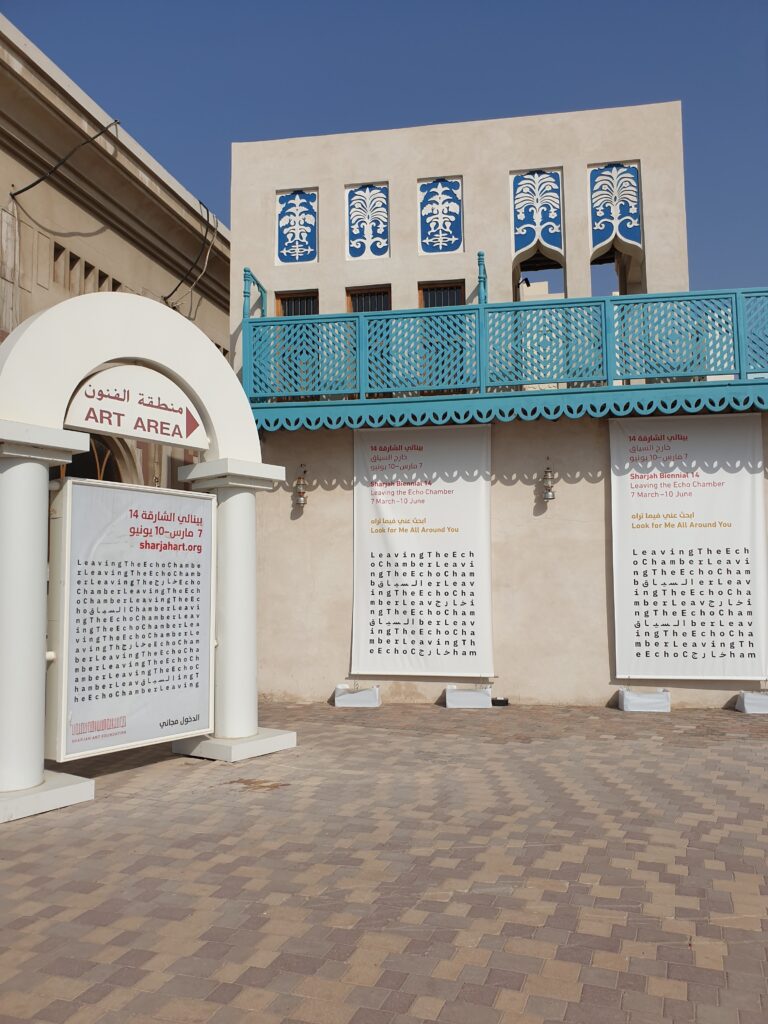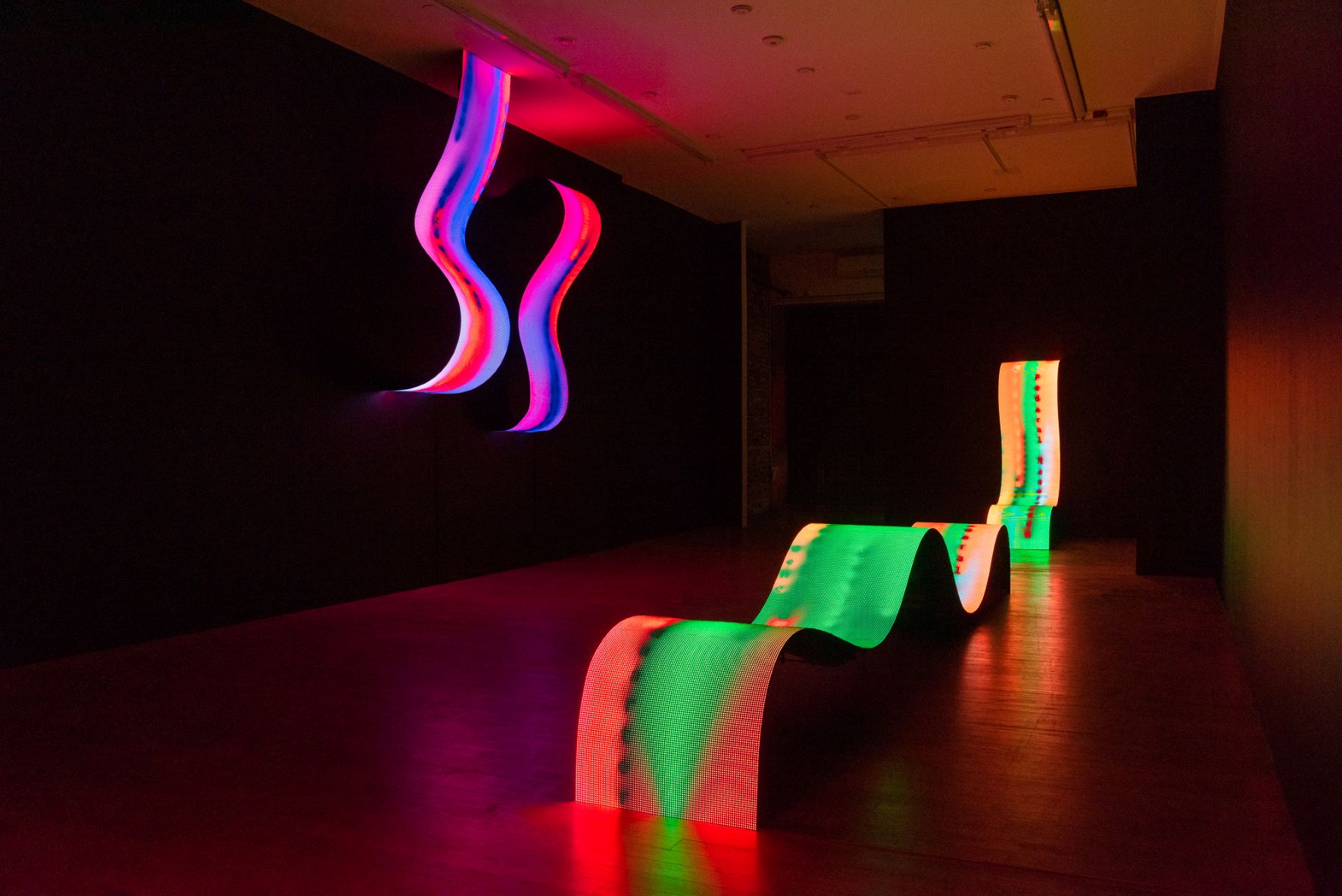
Sharjah Biennial 14 ‘Leaving the Echo Chamber’ (7 March – 10 June 2019): Exploring Displacement, Appropriating Media, and Addressing Time
April 19, 2019
The curatorial projects of the Sharjah Biennial 14, titled “Leaving the Echo Chamber” take place across multiple venues, including the Sharjah Arts Square and the Sharjah Art Museum, which I visited on April 19, 2019.
“After collecting vintage saris from India, Sharjah and her own Indo-Caribbean family, the artist wove them together to create an intimate textile topography.”*
“[The] merry-go-round was unearthed from the now closed Kalba Kindergarten and relocated to the Bait Obaid Al Shamsi courtyard…. this gesture of displacement introduces elements of youth, innocence and play amidst the ‘fiberscape’ of saris.”*
*[Text provided by Biennial]
Gestures of displacement and linking multiple cultures by the selection and/or appropriation of media is one of the consistent efforts made by artists across the curatorial projects of the Sharjah Biennial 14, titled “Leaving the Echo Chamber”. The project takes place across multiple venues, including the Sharjah Arts Square and the Sharjah Art Museum, which I visited on April 19, 2019.

Media: Mixed media installation, vintage saris, rope net, merry-go-round, 2-channel video, chalk
Artist: Suchitra Mattai – Artwork name: ‘Imperfect Isometry’ (2019) – Curator: Claire Tancons

Sharjah Biennial 14 venue

Sharjah Art Museum
As the introductory text suggests, the ‘echo chamber’ refers to news media and their prospective ‘feeds’, the “historical dominance of capital” along with the “systems that dictate [capital’s] access, production and distribution”, as well as the space of our memories and imagination. Infused with multiple meanings, the ‘echo chamber’ becomes subject to each artist’s interpretation and approach to the general Biennial topic.
Now “’Leaving’ the Echo Chamber” according to the text, does not, in fact, invite the viewer or participant to leave these implied references, but rather to “’renegotiate’ the shape, form and function [of the chamber]” bringing about the opportunity to ‘redefine’ the vibrations within.
It is an ambitious project, bringing about more than 80 artists presenting over 60 artworks, occupying several venues within the Emirate of Sharjah. The 3 curators approach the theme of the Biennial from different tangents, each occupying a different albeit powerful position with surprisingly little overlap with the others. Claire Tancons, Omar Kholeif and Zoe Butt curate an overwhelmingly critical selection of artworks and artists, with one of the main challenges seemingly to be appropriating the artists’ messages to the regional and timely contexts.

The architecture surrounding the courtyard of Bait Al Serkal

Alessandro Balteo-Yazbeck’s ‘All the Lands from Sunrise to Sunset’ (2019)
Claire Tancons’s “Look for Me All Around You” project focuses on migration and displacement. The venue is Bait Obaid Al Shamsi, two-tiered, vernacular architecture with wooden doors and mashrabiyyeh (screens) and courtyards. Suchitra Mattai’s work occupies one of the outdoor courtyard spaces, while the other two projects addressed here are interior interventions.
Carlos Martiel’s ‘Sabor a Lágrimas’ (2019) a performance piece delivered on 9 March 2019, has multiple, local cultural references. The performance re-enacted traditional pearl diving, which was common in the region, while stressing its taxing aspects (citing here the use of rope). The room in which the performance took place was appropriated; the floor is capped with thick, dewed glass, creating a physical reference to water. And, during the performance, guests were served with Arabic sweets with pearls. The impression is that this non-Arab artist has physically inserted himself into a local Arab practice, granting it new meaning because it is framed as a contemporary art event. The performance is replayed through a video in an installed screen in the space.
‘Any Way the Wind Blows’ (2018 – 2019) by Tracey Rose also employs the use of a screen with a video playing, shot at the Sharjah Ladies’ Club ice rink. The actual wooden boat used in the performance has been relocated to the venue, proudly displayed on the terrace as one enters the second-level room, decorated with flags.

Astrid Klein’s white painting ‘what are you fighting for?’ (1988-1993)

Pamela Rosenkranz’s ‘Healer’ (2019) a robotic snake in the courtyard of Bait Al Serkal.
While Claire Tancons’s curatorial work focuses mostly on performance, displacement and migrant imagery, Omar Kholeif’s “Making New Time” addresses the real versus the virtual, the spatial and temporal versus the physical and permanent. Omar Kholeif challenges our perception of contemporary art in today’s “age of constant speed”. He asks, “how do we slow down and ‘experience’ the experience? How do we make ‘new time’?”
Omar Kholeif’s first venue is Bait Al Serkal, which is traditional, vernacular architecture and part of the Arts Square. Most of the projects here aim to appropriate or relate to the space.
Astrid Klein presents her ‘white paintings’ series which employs a range of unlikely materials such as acrylic, quartz crystal, alabaster plaster and zinc white on canvas. The result, such as the Untitled ‘What are you fighting for’ artwork (1988–1993), is a contemporary, digital approach to a monochromatic color-field painting, with text. Stan Douglas’ various works from 2017, dubbed ‘synthetic pictures’, also uses digital techniques as the medium. The DCT (discrete cosine transform) and lacquered UV ink on gessoed panels recreate the effect of Ben-Day dots, or JPEG pixels, enlarged in scale in order to create bold and colorful patterns, very similar to Op Art in the aesthetic.
Other projects are more playful. Pamela Rosenkranz’s ‘Healer’ (2019) is a robotic snake propped into the courtyard of Bait Al Serkal. This ‘snake’ slithers, rises, twitches, moves, pauses and waits. As a piece of engineering-invention-meets-contemporary-art, it is a direct commentary on the replacement of the real and natural with the futuristic and technological in 2019.

Jon Rafman’s ‘Punctured Sky’ (2019) is an illustrated scroll created in collaboration with comic book artist Connor Willumsen.

The scroll is placed on a podium, laterally occupying the space, so the observer can read the narrative while slowly walking alongside the work.
Another site-specific work is Alessandro Balteo-Yazbeck’s ‘All the Lands from Sunrise to Sunset’ (2019) which occupies and re-imagines the space in the house of Issa bin Abdul Latif Al Serkal. Colorful strips of collage, colors and textures not only cover the walls and floor but actually breaks with and re-orients the original order and orientation of the traditional, vernacular space.
Jon Rafman’s ‘Punctured Sky’ (2019) is an illustrated scroll created in collaboration with comic book artist Connor Willumsen. The scroll is placed on a podium, laterally occupying the space, so the observer can read the narrative while slowly walking alongside the work. The nod to the scroll is obvious; it is the traditional method of transporting documents in the medieval history of the Arab region.
Across the Arts Square, the museum building, the Sharjah Art Museum, is another one of the Biennial’s venues. Here, Omar Kholeif’s project occupies the South wing, while Zoe Butt’s project “Journey Beyond the Arrow” occupies the North wing. Zoe Butt references the ‘arrow’ as a historical ‘tool’ and sheds light on artists that have questioned the ‘tools’ they have inherited through tradition, culture and history. She also invites them to redefine their ‘tools’ (be they physical or psychological).

Khadim Ali in collaboration with Sher Ali ‘Urbicide: Flowers of Evil’ (2019)

Interior view of Sharjah Art Museum
The artist that stands out the most in Zoe Butt’s project is unquestionably Khadim Ali, who has mastered medieval art-forms like tapestries and infused them with contemporary, political references. His project ‘Flowers of Evil’ (2019) examines and challenges what he calls “the normalisation of violence” in Afghanistan. Khadim Ali infuses traditional iconography with images of weaponry like missiles, bombs and warplanes as he addresses his main thesis.
The North wing of Sharjah Art Museum is animated by mixed media, reverse paintings on acrylic, photography and video, and even a sound project. Across the museum, on the South wing, Omar Kholeif presents more dated artworks, some from the 1950s and 1960s. Prominent artists like Marwan Kassab Bachi, a prominent Syrian artist who was very influential in the region, are amongst those included.

Huguette Caland at Sharjah Biennial 14

Huguette Caland at Sharjah Biennial 14

The author Maie El-Hage at Sharjah Biennial 14 (2019)
Experiencing the Sharjah Biennial 14 firsthand, and on a first-time visit to the Emirate of Sharjah, shed light on the prominence of this curatorial enterprise. As stated, the project is ambitious, but also relatable. Many artists were inspired by and incorporated local, cultural references, while others focused on the art spaces themselves creating site-specific works. The variety and playfulness of the media is not to be missed either.
Sharjah Biennial 14 is memorable, an experience I will not soon forget. It is also introspective, as many of the messages addressed local and timely issues of our contemporary condition, in this part of the world and globally. I will continue to assess what reverberates in my personal ‘echo chamber’ and in that of the art spaces created within and without.
You may also like
Mazen Khaddaj celebrates his first solo show in Dubai
Mazen Khaddaj's first solo show in Dubai 'New Self Found', curated by art historian Maie El-Hage, is
“A Salute to my Country” by Maroun Hakim honors Beirut through peace and turmoil
“A Salute to my Country” by Maroun Hakim is a collection of paintings and sculptures currently o
Multidisciplinary Artist Daniel Canogar Links History to Contemporary Times
New media artist Daniel Canogar presents his latest show “Loose Threads” at Galloire Contemporar








